Ardashir Papakan Palace: Discover Iran's Historic Splendor
Located in Fars province, one of Iran's most historically significant regions, Firozabad, known for its rich history, cultural heritage, and natural beauty, is a key area for nomadic culture in Iran.
Firozabad is home to numerous ancient sites that date back to previous eras. Among these, the Ardashir Papakan Palace stands out as a notable attraction.
This architectural marvel from the Sassanid era continues to draw visitors with its stunning design and artistic craftsmanship. This article provides detailed insights into the palace's history, architecture, and the optimal time for a visit.
Palace of Ardashir-e Babakan History

In ancient times, the city of Firozabad, formerly known as "Gor," was fortified by massive walls. When Alexander the Great attempted to conquer the city, he found the walls impenetrable. Instead, he diverted a nearby river, flooding the city, which was situated in a low-lying area, turning it into a lake. This lake persisted for centuries until Ardashir Papakan, the founder of the Sassanid dynasty, took measures to drain it. Afterward, the city was renamed "Ardashir Khore." Although the city later faced destruction during the Arab invasion, its ruler managed to regain control and redevelop it, leading to its current name, Firozabad.
The Ardashir Papakan Palace was constructed in 224 AD by Ardashir Papakan himself, marking one of the earliest architectural achievements of the Sassanid Empire. Situated in Firozabad, Fars province, this palace is over 1,800 years old. Some experts suggest that this structure may not have initially served as a palace but rather as a fire temple, due to its proximity to a spring. In ancient Iranian belief, buildings near water sources were often dedicated to Anahita, the goddess of water, leading to speculation that this site was a place of worship rather than a royal residence.
One prominent Iranian archaeologist argued that the structure lacked typical palace features and instead proposed that it was the largest fire temple in Fars province. However, other scholars maintain that Ardashir Papakan used this building as his official residence and seat of power.
Architecture of Ardeshir Palace
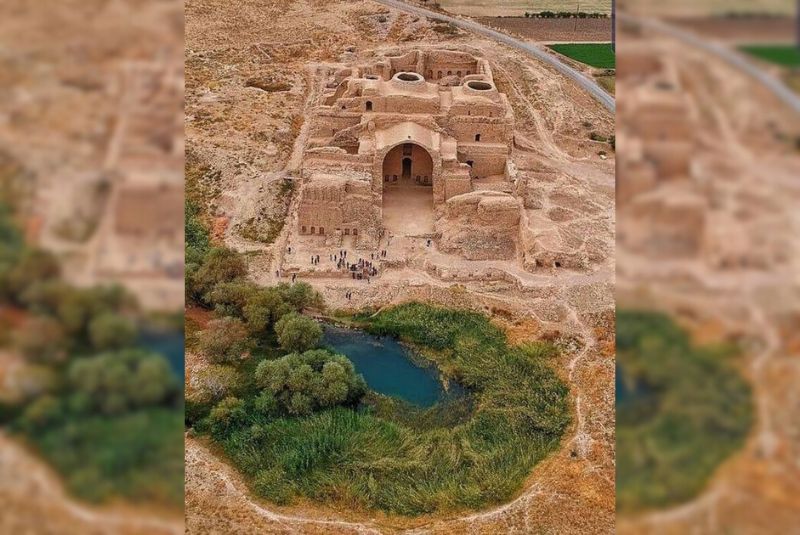
The Ardashir Papakan Palace complex measures 104 meters by 55 meters, with its architecture featuring three domes and various other elements, making it slightly larger and more elaborate than the nearby Dezh Dokhtar fortress. Unlike typical defensive structures, this palace was likely constructed to showcase the regal stature of Ardashir I, rather than to serve as a fortified stronghold. Despite the thick surrounding walls—twice as thick as those of Dezh Dokhtar—the building is more appropriately referred to as a palace than a castle.
The design of the palace suggests that it served as a venue for social gatherings where guests were presented to the imperial throne. The structure was built using local stone and mortar, with the interior adorned with plasterwork. The architectural style inside is reminiscent of the Tachara Palace at Persepolis.
Throne Chamber
The throne chamber connects to all four external walls of the palace through barrel-vaulted passages. The square hall is crowned with a dome, utilizing the innovative Fil-poosh technique, which transitions the space from a quadrangular base to a circular upper section, eventually forming an octagonal shape. This central domed chamber likely functioned as a reception or audience hall, serving as the heart of the palace complex. The main dome is flanked by two smaller domes, with a staircase behind the northern dome leading to the upper floor, which is believed to have housed the royal family's quarters.
Central Iwan
The central iwan, a grand arched hall, measures 14 meters in width, 22 meters in height, and 41 meters in length. Constructed with stone masonry and mortar, it features a barrel-vaulted ceiling. The iwan, an architectural innovation from the later Parthian period, became a defining characteristic of Sassanid palaces. This iwan leads into the palace's main domed hall, flanked by symmetrical rectangular antechambers, each also covered by barrel vaults. Though the iwan has partially collapsed, its design reflects the grandeur that would later culminate in the renowned Taq Kasra at Ctesiphon.
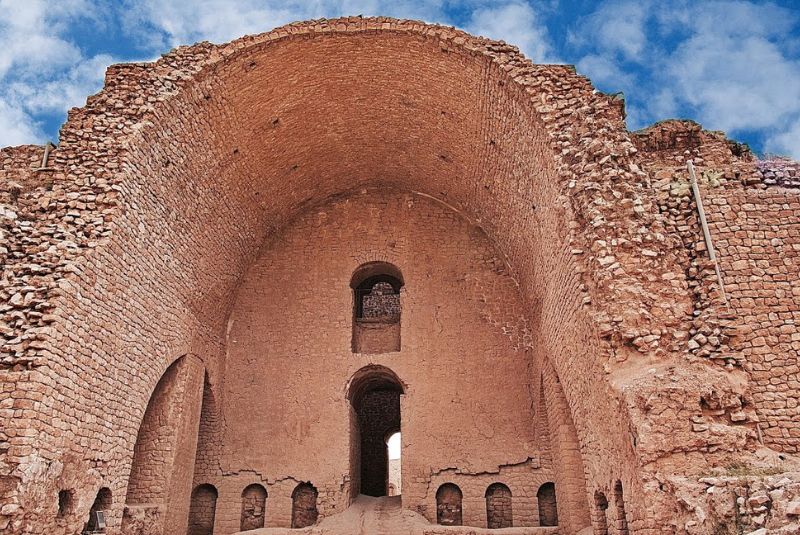
Lake and Garden
The palace overlooks a small lake, which is fed by a natural spring that also provided water to the ancient city of Ardashir-Khurra, formerly known as Gor. The main entrance iwan offers views of this lake, and it is believed that the palace was surrounded by a traditional Persian garden, similar to the bustan created by Cyrus at Pasargadae. The pond, which was tiled along its edges, was bordered by a paved area where guests of the royal court could enjoy peaceful evenings by the water.
Columns
The palace is supported by square columns and semi-columns made from clove stone, which are integrated into the arches. These columns resemble those from the Parthian era but are distinguished by intricate stucco moldings. The decorative cornices of the columns are also similar to those found in Persepolis. Despite the passage of centuries, these sturdy columns have remained largely intact.
Domes
Ardashir Papakan Palace features four domes, each with an opening at the top measuring one meter in diameter. The main dome was constructed using the Fil-poosh method, an architectural technique for building arches and domes that is still in use today. Despite the damage sustained over the years, these domes have remained resilient and stable. Considering that domed buildings were not yet widespread during the Sassanid period, the Palace of Ardashir-e Babakan stands as one of the earliest examples of domed architecture from this era.
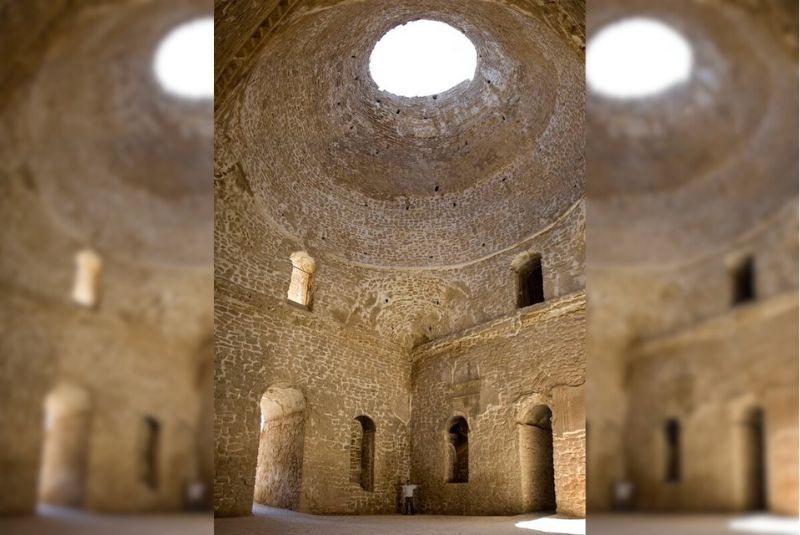
Firouzabad Fire Temple
During the reign of Ardashir Papakan, the people of the region were adherents of the Zoroastrian religion, which held fire as a sacred element believed to have the power to purify and destroy sins. As a result, a fire pit was constructed near the palace, which became known as the Great Fire Temple, also referred to as the Firouzabad Fire Temple or Barin.
Some Iranian archaeologists argue that this site was one of the most significant Zoroastrian fire temples for two main reasons. First, the current structure does not resemble a traditional palace, leading to the belief that it served a different purpose. Second, the Zoroastrian faith was widely practiced in the area at the time, making it likely that the building was used as a fire temple and a center for Zoroastrian rituals and ceremonies.
Location and Access
- Address: Fars province, 3 kilometers north of Firouzabad
Ardashir Papakan Palace is located 3 kilometers north of Firouzabad in Fars province. While the palace was previously free to visit, as of 2024, an entry fee is now required. Since the area lacks adequate lighting, it's recommended to visit between sunrise and sunset for the best experience.
How to Reach Ardashir Papakan Palace
There are two primary routes to access Ardashir Papakan Palace:
- Route 1 (from Firouzabad): Begin at Gaz Square in Firouzabad. Take the Kovar-Firouzabad road and travel approximately eight kilometers to reach Ardashir Papakan Palace.
- Route 2 (from Shiraz): Start by taking the Shiraz-Jahrom-Larestan road and continue onto the Shiraz-Kovar road. From there, proceed on the Kovar-Firouzabad road towards Qala Dokhtar. After passing Qala Dokhtar, you will reach the Inter-Passage Forest Park. Continue past the park, following signs to Ardashir Papakan Palace. The total distance from Shiraz to the palace is roughly 100 kilometers.
Best Time to Visit Ardashir Papakan Palace
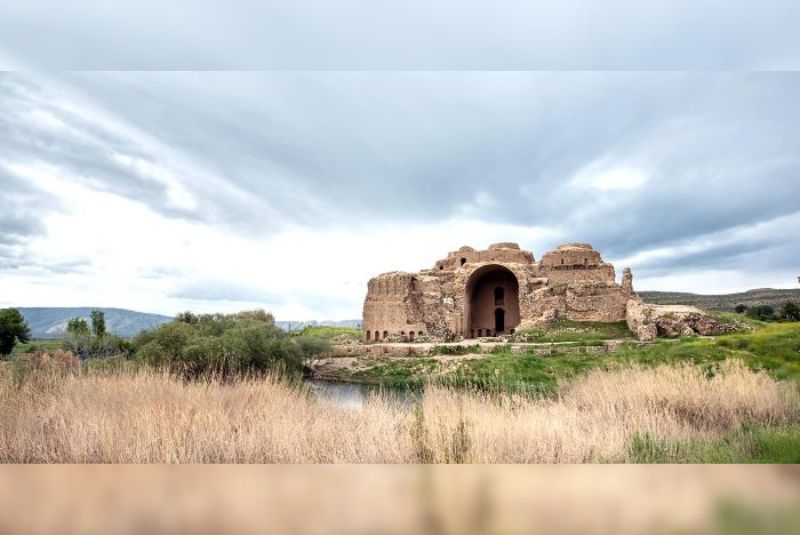
The ideal time to visit Ardashir Papakan Palace is during the spring, particularly in May when the orange trees are in bloom. During this season, the natural beauty of Fars province, combined with the blossoming orange trees surrounding the palace, enhances the historical site's charm. The mild, cool spring weather also makes it more comfortable for visitors to explore the palace and its green surroundings, allowing them to fully appreciate its architecture and serene atmosphere.
Nearby Attractions
The area around the Palace of Ardashir-e Babakan is rich in historical and natural attractions that offer a comprehensive experience of Iranian culture. Just a short distance from the palace, visitors can explore sites like:
- Qala Dokhtar of Firouzabad
- Imamzadeh Jafar
- Naqar Khane
- Hassan-abad Castle
Accommodation Options Near Ardashir Papakan Palace
Those seeking accommodations in proximity to the Ardashir Papakan Palace will find a diverse range of options to suit their needs. From modern hotels to traditional and environmentally friendly lodgings, travelers can select accommodations that align with their preferences. Several establishments, including the Firouzabad Tourist Hotel and the Elsavan Ecotourism Residence, offer convenient access to the region's historical and cultural treasures, making them ideal bases for exploring the area and visiting the palace.
Culinary Delights Near the Palace

The vicinity of the Palace of Ardashir-e Babakan boasts a vibrant culinary scene, catering to a variety of tastes. From local specialties to international fare, visitors can savor delicious meals in charming settings. Notable dining establishments in the area include:
- Nasiri Restaurant
- Jahangardi Hotel Restaurant
- Shah Balut Restaurant
- Kilagh (Aria) Tourist Complex Restaurant
- Bomgardi Elsavan Restaurant
- Kandu Restaurant
- Mehestan Restaurant
These restaurants collectively contribute to an unforgettable experience in this historic region.
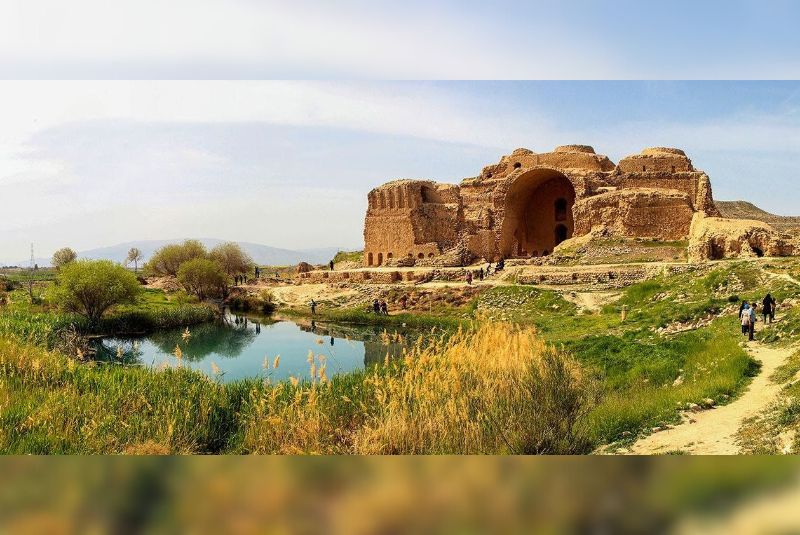
Final Takeaway
Ardashir Papakan Palace is a remarkable example of Sassanian architecture. The palace demonstrates the skill and artistry of Sassanian architects through its innovative dome and porch, as well as its intricate interior and exterior plasterwork. This architectural style significantly influenced subsequent building designs.
When visiting Shiraz, allocate a day to explore this impressive palace and gain a deeper understanding of Iran's history.
Share your story!
Comment below and let us know about your Experience.
Your story inspires others!


Comment
Leave a Comment